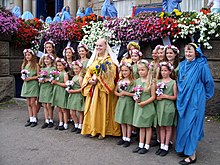Gorsedh Kernow
The Gorsedh Kernow is a bards association from Cornwall with the aim of researching Celtic literature, art and music, promoting the Cornish language and cultivating contacts with other Celtic cultures. Such is found in Brittany and in Wales , where the Breton and Welsh also still Celtic languages are spoken. There are also corresponding bard associations with the Gorsedd of Bards and the Goursez Breizh . The word Gorsedh is borrowed from the Welsh Gorsedd and means throne . Kernow is the Cornish name of Cornwall. In English the term Gorsedd of the Bards of Cornwall is used. The Gorsedh Kernow is attributable to the movements of the Celtic neo-paganism .
history
A well-known early medieval bard association probably originated in Cornwall, because in the Welsh Triads from the 6th century AD, the Gorsedd of Boskawen of Dumnonia is referred to as one of the three great Gorsedds of Poetry of the Island of Britain . Some researchers now assumed that Boskawen was the stone circle of Boscawen-ûn in Cornwall and that Celtic bard rituals were held there. Dumnonia was a Celtic kingdom in post-Roman Britain that probably included Cornwall. In 1928, Henry Jenner set up this Cornish Bard Association on this stone circle as part of the revival of the Cornish language and culture. The Archdruid (Archdruid) of the Gorsedds of Wales who had traveled there appointed Jenner Grand Bard and twelve other chosen ones to simple bards in the founding ceremony. Since then, with the exception of the period between 1939 and 1945, an Open Gorsedh has been celebrated on the first Saturday in September , which was based on supposed Celtic ceremonies. After the rush had increased, the Open Gorsedh was no longer held at the difficult-to-access stone circle of Boscawen-ûn, but in larger places with better parking facilities.
Open Gorsedh
At the annual Open Gorsedh, the deceased is remembered first. Subsequently, prizes are awarded to writers, poets and artists who have made a contribution to the preservation and promotion of the Cornish language. A highlight of the celebration is the flower dance of costumed children and the offering of flowers and herbs to the Lady of Cornwall . The Gorseddau delegates from Wales and Brittany, identified by the colors of their robes, give short speeches in their own language. Newly entering bards are then solemnly welcomed by the great bards by giving the novices Celtic names that reflect their origins or interests. The ceremony ends with the oath on the sword of Cornwall, which the legendary sword Excalibur of King Arthur is supposed to represent. Finally they sing the Cornish national anthem Bro Goth Agan Tasow together .
membership
You can only become a member on the recommendation of bards and by resolution of the Gorsedh. Mastery of the Cornish language is not required, but it is certainly helpful. Bards wear a ceremonial blue robe with a headscarf during celebrations. In contrast to the Gorseddau from Wales and Brittany, where there are three ranks of ovates , bards and druids with the archdruid (archdruid) as head, the Gorsedh Kernow is content with simple bards and grand bard (great bard ) as head, who, like the archdruids, is only elected for a period of three years. There are currently around 500 bards.
Great bards
Since the re-establishment in 1928 there have been a total of 19 great bards.
- 1928–1934: Gwas Myhal (Henry Jenner)
- 1934–1959: Mordon (Robert Morton Nance)
- 1959–1964: Talek (EG Retallack Hooper)
- 1964–1970: Gunwyn (George Pawley White)
- 1970–1976: Trevanyon (Denis Trevanion)
- 1976–1982: Map Dyvroeth (Richard Jenkin)
- 1982–1985: The Great (Hugh Miners)
- 1985–1988: Map Dyvroeth (Richard Jenkin)
- 1988–1991: Gwas Constantyn (Dr John Chesterfield)
- 1991–1994: Caradok (Jori Ansell)
- 1994–1997: Cummow (Revd Brian Coombes)
- 1997–2000: Bryallen (Ann Trevenen Jenkin)
- 2000–2003: Jowan to Cleth (John Bolitho)
- 2003-2006: Tewennow (Rod Lyon)
- 2006–2009: Gwenenen (Vanessa Beeman)
- 2009–2012: Skogyn Pryv (Mick Paynter)
- 2012–2015: Steren Mor (Maureen Fuller)
- 2015–2018: Telynor to Weryn (Merv Davey)
- since 2018: Melennek (Elizabeth Carne)
The Awen
The Gorseddau of Cornwall and Wales use the Awen / | \ is used, which represents sun rays emanating from a center and is supposed to symbolize the virtues of love , justice and truthfulness . Awen is Welsh and means muse or inspiration. It probably goes back to Edward Williams , the founder of the Welsh Gorsedds of Bards, who used it very little himself. It was first seen in proclamations in 1833 and on banners of the Gorsedds of Bards in 1850 . Today this sign is used extensively. The Bretagne Bards Association also uses this symbol.
Individual evidence
- ↑ http://gorsedhkernow.org.uk/about.html
- ↑ https://en.oxforddictionaries.com/definition/gorsedd
- ↑ http://www.historic-cornwall.org.uk/a2m/bronze_age/stone_circle/boscawen_un/boscawen_un.htm
- ↑ a b http://gorsedhkernow.org.uk/history.html
- ↑ a b http://gorsedhkernow.org.uk/regalia.html
- ↑ http://gorsedhkernow.org.uk/bards.html
- ↑ http://gorsedhkernow.org.uk/grandbards.html
- ↑ Archive link ( Memento of the original from August 13, 2009 in the Internet Archive ) Info: The archive link was inserted automatically and has not yet been checked. Please check the original and archive link according to the instructions and then remove this notice.

